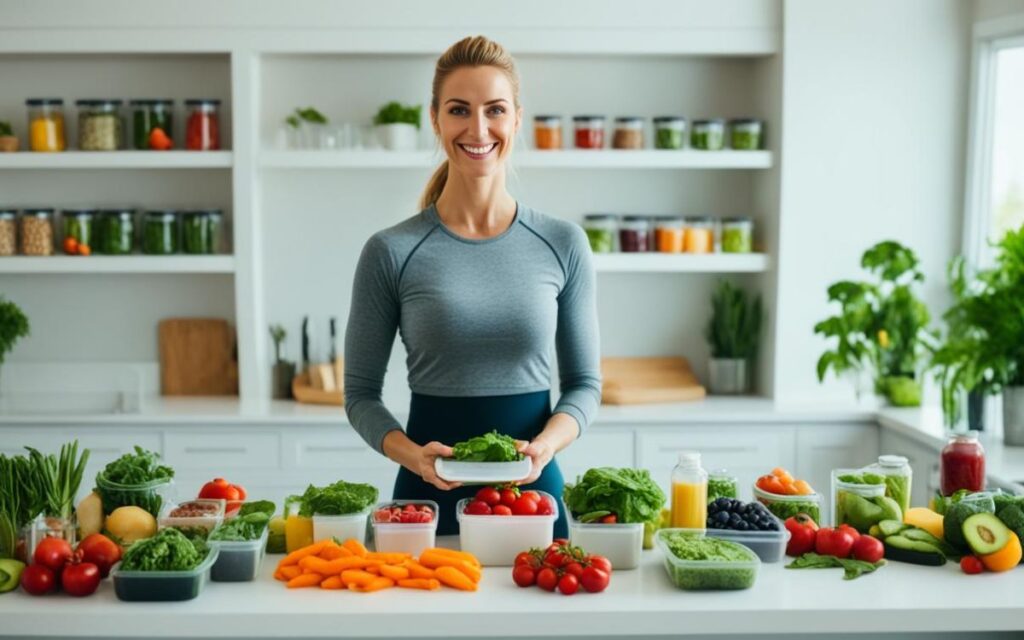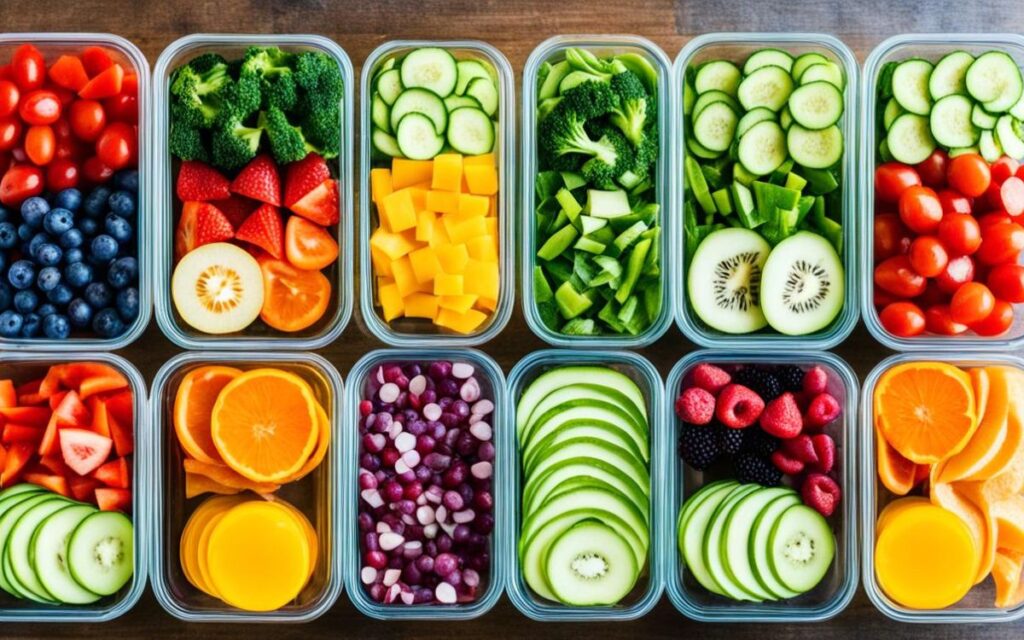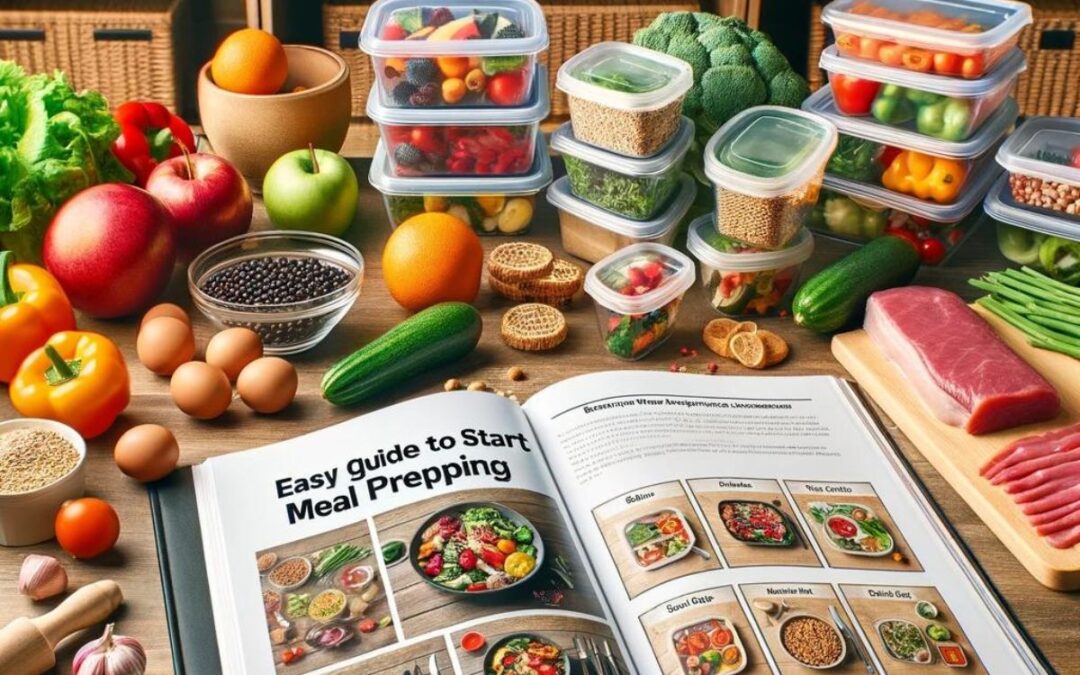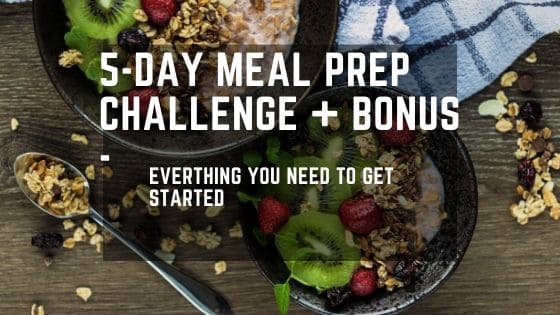Last Updated on March 10, 2024 by TheMealPrepNinja
If you’re looking to save time, money, and reduce food waste in the kitchen, meal prepping is a game-changer. However, if you’re new to meal prepping, it can be overwhelming at first. But fear not! I’m here to guide you through the process and make it easy for you to start your meal prepping journey.
In this easy guide, I’ll provide you with all the information you need to get started with meal prepping as a beginner. From understanding the benefits of meal prepping to learning the basics, essential tools, creating a meal prepping plan, and handling food safely, you’ll have everything you need to kickstart your meal prep journey.

Key Takeaways:
- Meal prepping can save you time, money, and reduce food waste in the kitchen.
- Starting your meal prepping journey as a beginner doesn’t have to be overwhelming.
- Understanding the benefits of meal prepping is essential for motivation and long-term success.
- Having the right tools and creating a meal prepping plan are crucial for a smooth meal prep experience.
- Food safety should be a top priority when handling and storing prepped meals.
This post may contain affiliate links, which means we may receive a commission, at no extra cost to you, if you purchase through a link.
The Benefits of Meal Prepping
Meal prepping offers a multitude of benefits that can make your life easier and healthier. By investing some time upfront in prepping your meals, you can streamline your time in the kitchen throughout the week. This means less time spent cooking and cleaning up after meals, allowing you to focus on other important tasks.
Streamline Your Time in the Kitchen
Meal prepping helps you save time in the kitchen by doing the preparation work in advance. By cooking large batches of food and portioning them into individual servings, you can have ready-made meals for the entire week.
This eliminates the need for daily cooking and allows you to simply reheat and enjoy your prepped meals. With less time spent cooking, you’ll have more time for yourself, family, or other activities.
Control Portions for Healthier Eating
Meal prepping enables you to have better control over your portions, which is crucial for maintaining a healthy diet. When you portion out your meals in advance, you can ensure that you’re eating the right amount of food for each meal.
This helps prevent overeating and promotes healthier eating habits. By having pre-portioned meals ready to go, you’ll be less tempted to indulge in larger servings or unhealthy snacks.
Save Money and Reduce Food Waste
Meal prepping is not only beneficial for your time and health but also for your wallet and the environment. By planning and prepping your meals in advance, you can create a budget-friendly meal plan that avoids unnecessary food purchases. This helps you cut down on food expenses and reduces the chances of buying items that may go to waste. Additionally, meal prepping allows you to utilize ingredients more efficiently, reducing food waste and contributing to a sustainable lifestyle.
Overall, the benefits of meal prepping are significant. It saves you time in the kitchen, promotes portion control for healthier eating, helps you save money, and reduces food waste. By incorporating meal prepping into your routine, you can establish healthy eating habits and improve your lifestyle.
Understanding Meal Prepping Basics
To start your meal prepping journey, it’s important to understand the basics. Meal prepping is the process of preparing meals or recipes in advance, then portioning them out to create grab-and-go meals for later. This method has gained popularity due to its convenience, efficiency, and potential for healthier eating. It allows you to have home-cooked meals without dedicating time every day to preparation.
Meal prepping offers several advantages, but it’s essential to consider the trade-offs compared to cooking daily.
Defining Meal Prepping and Its Popularity
Meal prepping has become increasingly popular among individuals looking to save time and simplify their meal planning. By dedicating a few hours to meal preparation each week, you can significantly streamline your cooking process and ensure that you always have healthy, ready-to-eat meals on hand.
Meal prepping offers a variety of benefits, including:
- Convenience: With prepped meals, you can easily grab a nutritious option and avoid the need to cook every day.
- Efficiency: By cooking in batches, you save time and energy in the kitchen.
- Healthier Eating: Meal prepping allows you to have control over your portion sizes and ingredients, making it easier to maintain a balanced diet.
Meal Prepping vs. Cooking Daily: The Trade-offs
While meal prepping offers significant benefits, it also comes with trade-offs that may not be suitable for everyone.
Some considerations to keep in mind include:
- Eating the Same Meals: When you meal prep, you often end up eating the same meals for a few days in a row. While this can be convenient and time-saving, it may not suit those who crave variety.
- Planning Ahead: Meal prepping requires planning and organizing your meals in advance. If you prefer spontaneous cooking or dining out, this level of structure may not be ideal.
Considering the advantages and trade-offs of meal prepping will help you determine if it aligns with your lifestyle and goals. By understanding the basics and evaluating your preferences, you can make an informed decision about incorporating meal prepping into your routine.
You can also meal prep for families or meal prep for one person.
How to Start Meal Prepping for Beginners
Now that you have a basic understanding of meal prepping, it’s time to dive into the specifics of getting started. In this section, I will guide you through the step-by-step process of meal prepping for beginners. Follow these simple steps to set yourself up for success in your meal prepping journey.
- Plan your meals and recipes: Begin by deciding what meals you want to prep for the week. Consider your dietary preferences, nutritional needs, and any specific goals you may have. Look for healthy recipes that are suitable for meal prepping and can be easily portioned out and reheated.
- Organize a meal prep schedule: Choose a specific day or days of the week to dedicate to meal prep. This could be on the weekend or a day when you have more free time. Create a schedule that works for you and allows you to prepare meals in advance.
- Gather the necessary ingredients: Make a grocery list based on the recipes you have selected. Ensure you have all the ingredients on hand before you start prepping. This will save time and help you stay organized.
- Prepare your ingredients: Once you have your ingredients, start prepping them. This may include washing and chopping vegetables, marinating meats, or cooking grains. By prepping your ingredients in advance, you’ll save time during the actual meal prep process.
- Cook and assemble your meals: Cook your meals according to the recipes you’ve chosen. Use appropriate cooking techniques such as baking, grilling, or sautéing. Once the meals are cooked, portion them out into individual containers. Make sure to use meal prep containers that are microwave-safe, dishwasher-safe, and freezer-safe.
- Label and store your meals: Label each meal container with the date and contents. This will help you keep track of what you have and when it was prepared. Store your prepped meals in the refrigerator or freezer, depending on when you plan to consume them.
By following these steps, you’ll be well on your way to becoming a meal prepping pro. Remember, practice makes perfect, so don’t be discouraged if it takes a few tries to find a meal prep routine that works best for you. With time and experience, you’ll become more efficient and creative in your meal prepping endeavors.
Essential Kitchen Tools for Meal Prep
To effectively meal prep, you’ll need a few essential kitchen tools. This section will guide you in selecting the right meal prep containers and cookware that will optimize your meal prep process.
Selecting the Right Meal Prep Containers
Choosing the right meal prep containers is crucial for keeping your prepped meals fresh and easily accessible. Look for containers that are microwave-safe, dishwasher-safe, and freezer-safe. This versatility will allow you to heat up your meals, clean the containers effortlessly, and store leftovers for future use.
When selecting meal prep containers, consider investing in an assortment of different shapes and sizes. This variety will accommodate various meal sizes and types. For example, opt for larger containers for main dishes and smaller ones for snacks or sides. Having a range of container sizes will allow you to portion out your meals effectively and ensure that each meal is adequately stored.
Cookware Needed for Efficient Prepping
In addition to meal prep containers, having the right cookware will make your meal prep experience more efficient and enjoyable.
Here are some essential cookware items that you should consider including in your kitchen:
- A large skillet: Perfect for sautéing vegetables and cooking proteins.
- A chef’s knife: An all-purpose knife for chopping, dicing, and slicing ingredients.
- A cutting board: Provides a sturdy surface for preparing ingredients.
- A pot: Ideal for boiling pasta, cooking grains, and making soups or stews.
- A roasting pan: Great for roasting meats and vegetables.
- A spatula: Useful for flipping and stirring ingredients while cooking.
Having these essential cookware items will enable you to tackle a wide range of recipes and make the meal prep process more efficient and enjoyable.
Creating Your Meal Prepping Plan
A well-structured meal prepping plan is vital for successful and efficient meal prep. It ensures that you have a clear roadmap and guidelines to follow throughout the process. In this section, I will guide you through the key steps of creating your meal prepping plan, from choosing meals and recipes to organizing a meal prep schedule.
Choosing Meals and Recipes to Prep
When selecting meals and recipes for your meal prep, it’s essential to choose options that can be easily portioned out and reheated without compromising taste and quality. Consider dishes that can withstand the reheating process and maintain their texture and flavor. Seek recipes that have minimal preparation requirements and can be stored well. This will make your meal prep sessions more efficient and enjoyable, ensuring that you have delicious and nutritious meals throughout the week.
Here are a few tips for choosing meals and recipes for your meal prep:
- Select recipes that incorporate a variety of proteins, carbohydrates, and vegetables to ensure a well-balanced diet.
- Opt for versatile dishes that can be easily customized or adapted to suit different preferences and dietary needs.
- Consider recipes that can be prepared in large quantities without compromising taste or quality.
- Utilize online resources and recipe platforms that specialize in meal prepping to explore a wide range of options.
Chicken and rice meal prep recipe Ideas
Chicken and rice meal prep for weight loss
Yoshinoya Copycat Recipe Meal Prep
Organizing a Meal Prep Schedule
Once you have selected your meals and recipes, it’s time to organize a meal prep schedule. A well-planned schedule will help you stay organized and ensure that your meal prepping sessions run smoothly. This includes planning your grocery shopping trips, prepping sessions, and cooking times.
Here are some steps to help you organize your meal prep schedule:
- Choose a specific day or days of the week dedicated to meal prepping. This will depend on your personal schedule and availability.
- Create a weekly meal planner to map out your meals for each day of the week. This will provide guidance on the quantity and variety of meals you need to prep.
- Create a comprehensive grocery list based on the ingredients required for your chosen meals and recipes.
- Plan your grocery shopping trips in advance, ensuring that you have all the necessary ingredients on hand.
- Allocate specific time slots for each meal prep session, accounting for the preparation, cooking, and storage of each meal.
- Consider batch cooking techniques to streamline the meal prep process and maximize efficiency.
By following these steps and creating a well-thought-out meal prep schedule, you’ll be able to stay organized, save time, and ensure a variety of delicious and nutritious meals throughout the week.
The Art of Grocery Shopping for Meal Prep
Grocery shopping is an essential component of successful meal prepping. By efficiently planning your grocery trips and understanding how to build a budget-friendly grocery list, you can save money, reduce food waste, and ensure that you have all the necessary ingredients for your meal prep sessions.
Building a Budget-Friendly Grocery List
When creating your grocery list for meal prep, it’s important to prioritize budget-friendly options. Here are some tips to help you build a wallet-friendly grocery list:
- Plan your meals: Before heading to the grocery store, take some time to plan your meals for the week. This will help you determine the ingredients you need and avoid unnecessary purchases.
- Take inventory of your pantry: Check your pantry and refrigerator to see what ingredients you already have. This will prevent you from buying duplicates and wasting money.
- Shop in season: Seasonal produce tends to be more affordable and fresher. Take advantage of local farmers’ markets or look for discounts on seasonal fruits and vegetables at the grocery store.
- Compare prices: Be mindful of prices and compare options. Consider store brands or bulk options to save money without compromising on quality.
- Use coupons and discounts: Look for coupons, digital discounts, or loyalty programs offered by the grocery store. This can help you save money on your overall grocery bill.
By implementing these strategies, you can build a budget-friendly grocery list and maximize your savings while still enjoying nutritious and delicious meals.
Pantry Staples for Meal Prep Success
In addition to planning a budget-friendly grocery list, it’s essential to have a well-stocked pantry to support your meal prep endeavors. Pantry staples provide the foundation for many meal prep recipes and can add flavor, texture, and variety to your meals. Here are some pantry staples that are essential for meal prep success:
- Dried grains: Stock up on versatile grains like rice, quinoa, oats, and pasta. These grains can be used as a base for many meal prep dishes.
- Beans and legumes: Canned or dried beans, chickpeas, and lentils are excellent sources of protein and can be incorporated into soups, stews, and salads.
- Canned goods: Keep a variety of canned goods on hand, such as diced tomatoes, coconut milk, and broth. These ingredients are convenient and can enhance the flavors of your meals.
- Spices and herbs: Build a collection of spices and herbs to add depth and flavor to your meals. Some versatile options include garlic powder, chili powder, cumin, oregano, and basil.
- Condiments and sauces: Have your favorite condiments and sauces available, such as soy sauce, hot sauce, olive oil, and vinegar. These can transform simple ingredients into flavorful meals.
By having these pantry staples readily available, you’ll have more flexibility and creativity in your meal prep recipes and be able to create delicious and well-balanced meals without relying on last-minute grocery runs.

Meal Prepping Steps Simplified
In this section, I will break down the meal prepping process into simplified steps to make it easier for beginners to follow. By following these steps, you’ll be able to streamline your meal prep routine and save time and effort throughout the week.
Batch Cooking Strategies
One of the key elements of meal prepping is batch cooking. This involves cooking larger quantities of food at once, so you have meals ready to go for multiple days. Here are some batch cooking strategies to consider:
- Choose recipes that are easy to scale up and can be stored well.
- Prepare ingredients in bulk, such as chopping vegetables or marinating meat, to save time during the cooking process.
- Utilize your oven and stovetop efficiently by cooking different components of your meals simultaneously.
- Use slow cookers or pressure cookers to cook large batches of soups, stews, or proteins.
By implementing these batch cooking strategies, you’ll be able to prepare a variety of meals in advance, making your meal prep sessions more efficient and effective.
Portioning and Storing Your Meals
Proper portioning and storage are crucial for successful meal prepping. Here’s how you can ensure your meals stay fresh and flavorful:
- Use meal prep containers that are durable, leak-proof, and freezer-safe. Select containers of different sizes to accommodate different meal portions. Consider investing in portion control containers if you’re looking to manage your calorie intake.
- Allow your cooked meals to cool completely before portioning them into individual containers. This prevents moisture buildup and keeps your meals from becoming soggy.
- Label each container with the meal name and date to easily identify and rotate your meals in the refrigerator or freezer.
- Store your meals in the refrigerator for up to 3-4 days or in the freezer for up to 3 months, depending on the recipe and ingredients.
By following these portioning and storage guidelines, your meals will maintain their quality and taste, allowing you to enjoy convenient and nutritious meals throughout the week.
| Batch Cooking Strategies | Portioning and Storing Tips |
|---|---|
| Choose recipes that are easy to scale up and can be stored well. | Use meal prep containers that are durable, leak-proof, and freezer-safe. |
| Prepare ingredients in bulk to save time during the cooking process. | Allow your cooked meals to cool completely before portioning them into individual containers. |
| Cook different components of your meals simultaneously. | Label each container with the meal name and date for easy identification. |
| Utilize slow cookers or pressure cookers for large batches of soups or proteins. | Store meals in the refrigerator for up to 3-4 days or in the freezer for up to 3 months. |
By implementing these meal prepping steps, you’ll be able to efficiently prepare and store your meals, ensuring convenience and healthy eating throughout the week.
Preserving the Freshness of Your Prepped Meals
To ensure the longevity and freshness of your prepped meals, it’s important to employ proper food storage solutions. By implementing effective storage techniques, you can maximize the shelf life of your meals and maintain their quality. Additionally, freezing meals can be a great option for extending their freshness and providing variety in your meal options.
Food Storage Solutions for Longer Shelf Life
When it comes to storing your prepped meals, choosing the right containers is crucial. Opt for high-quality meal prep containers that are airtight and leak-proof. These containers will help prevent moisture and oxygen from entering, which can lead to spoilage. Make sure to label each container with the name and date of the meal to keep track of freshness.
In addition to using proper containers, consider the following food storage solutions:
- Use portioned containers: Dividing your meals into individual portions will make it easier to grab and heat a single serving, reducing the risk of food waste.
- Separate wet and dry ingredients: If your meal includes ingredients with different moisture levels, separate them in the container to maintain their freshness. For example, keep sauces or dressings in a separate compartment.
- Wrap ingredients separately: To preserve the texture and flavor of your prepped meals, wrap ingredients like proteins or veggies individually with plastic wrap or foil before placing them in the container.
Freezing Techniques for Meal Prepping
Freezing meals can be a convenient way to extend their shelf life and add variety to your meal prep routine. Follow these freezing techniques for optimal results:
- Cool the meals completely: Allow your prepped meals to cool down to room temperature before placing them in the freezer. This helps prevent condensation and freezer burn.
- Choose freezer-friendly recipes: Certain dishes freeze better than others. Opt for recipes that are less likely to experience texture or flavor changes upon thawing. Soups, stews, casseroles, and baked goods are generally freezer-friendly.
- Use freezer-safe containers: Invest in freezer-safe meal prep containers that are designed to withstand low temperatures. These containers help protect your meals from freezer burn and preserve their quality.
- Label and date your meals: Similar to storing meals in the refrigerator, labeling and dating your frozen meals is essential for keeping track of freshness and ensuring you consume them within a reasonable timeframe.
- Thaw properly before reheating: When it’s time to enjoy your frozen meal, thaw it in the refrigerator overnight or use the defrost setting on your microwave. Thawing in the refrigerator is recommended to maintain the integrity and texture of the meal.
By implementing these food storage solutions and freezing techniques, you can prolong the freshness of your prepped meals and enjoy a variety of delicious options throughout the week.
| Food Storage Solutions | Freezing Techniques |
|---|---|
| Choose high-quality meal prep containers | Cool meals before freezing |
| Label containers with names and dates | Opt for freezer-friendly recipes |
| Portion meals into individual containers | Use freezer-safe containers |
| Separate wet and dry ingredients | Label and date your frozen meals |
| Wrap ingredients separately | Thaw properly before reheating |
Handling Food Safely During Meal Prep
When it comes to meal prepping, ensuring food safety is paramount. By following proper food handling practices and storage guidelines, you can protect yourself and your loved ones from foodborne illnesses. In this section, I will provide you with essential guidance on handling food safely during meal prep, as well as best practices for reheating prepped meals.
Navigating Food Safety and Storage Guidelines
Understanding and adhering to food safety and storage guidelines is crucial for maintaining the quality and safety of your prepped meals. Here are some key points to keep in mind:
- Always wash your hands thoroughly with soap and warm water before and after handling food.
- Ensure that all utensils, cutting boards, and surfaces are properly cleaned and sanitized before use.
- Separate raw meats, poultry, and seafood from other foods to prevent cross-contamination.
- Store perishable ingredients and prepped meals in the refrigerator at or below 40°F (4°C) to slow down the growth of bacteria.
- Label and date your prepped meals to keep track of their freshness and consume them in a timely manner.
By following these food safety guidelines, you can minimize the risk of foodborne illnesses and enjoy your prepped meals with peace of mind.
Best Practices for Reheating Prepped Meals
Reheating prepped meals properly is essential to ensure that they are safe to eat. Here are some best practices to follow:
- Thoroughly reheat prepped meals to an internal temperature of 165°F (74°C) using a food thermometer. This will eliminate any potential bacteria present.
- If reheating in the microwave, stir the food midway through to ensure even heating.
- Avoid reheating the same meal multiple times, as this can increase the risk of bacterial growth. Instead, portion your meals and only reheat what you plan to consume in one sitting.
- Discard any leftover prepped meals that have been left at room temperature for more than 2 hours to prevent bacterial growth.
By following these best practices, you can confidently enjoy your reheated prepped meals without compromising your health.
Easy Meal Prep Recipe Ideas
Looking for easy meal prep recipe ideas to kickstart your meal prepping journey? Whether you’re a beginner or seasoned meal prepper, these quick and healthy meals will make your life easier and keep you nourished throughout the week. From time-saving breakfast options to satisfying lunch and dinner recipes, there’s something for everyone. Plus, we’ve got you covered with vegetarian meal prep ideas for those following a plant-based diet. Let’s dive in!
Quick and Healthy Meals for Beginners
If you’re new to meal prepping, these easy recipes are perfect for getting started. Not only are they delicious, but they’re also packed with nutrients to fuel your body. Here are a few ideas to inspire your meal prepping journey:
- Quinoa Power Bowls: Prepare a batch of quinoa, then add roasted vegetables, grilled chicken or tofu, and your favorite dressing for a nutritious and satisfying meal.
- Turkey and Veggie Egg Muffins: Whip up a batch of these protein-packed egg muffins. Simply combine whisked eggs, cooked turkey, sautéed vegetables, and bake in a muffin tin for a grab-and-go breakfast option.
- Mason Jar Salads: Layer your favorite salad ingredients in a mason jar, starting with the dressing at the bottom, followed by hearty toppings, and ending with leafy greens. Now, you have portable and refreshing salads ready to enjoy throughout the week.
Healthy Ground Turkey Breakfast Bowl Recipe
Vegetarian Meal Prep Ideas for a Healthy Diet
For those following a vegetarian or plant-based diet, here are some flavorful and nutritious meal prep ideas:
- Vegetable Stir-Fry: Sauté a variety of colorful vegetables, such as bell peppers, broccoli, and snap peas with your favorite sauce. Portion it out and pair it with brown rice or quinoa for a satisfying meal.
- Lentil Stew: Cook up a hearty lentil stew with plenty of vegetables and aromatic spices. It’s a comforting and filling option that is perfect for colder days.
- Roasted Veggie Wraps: Roast a variety of vegetables like zucchini, bell peppers, and onions, and spread some hummus on whole-wheat wraps. Add the roasted veggies along with fresh greens for a quick and nutritious lunch option.
Whether you’re aiming for weight loss, looking to maintain a healthy diet, or seeking convenience, these easy meal prep recipe ideas will help you achieve your goals. With a little planning and preparation, you can enjoy delicious and nourishing meals throughout the week without the hassle of daily cooking. So, grab your meal prep containers and get ready to embark on a journey of healthy eating!

Conclusion
In conclusion, embracing meal prepping can lead to long-term success in maintaining a healthy and efficient lifestyle. By taking the time to plan and prepare your meals in advance, you can enjoy numerous benefits such as saving time and money, reducing food waste, and controlling portion sizes for healthier eating habits.
To start your meal prepping journey, it is essential to start small and gradually expand your meal prep skills. Begin by selecting a few meals to prep each week and gradually increase the number as you become more comfortable with the process. This approach allows you to build confidence and establish a routine that fits seamlessly into your schedule.
Remember to focus on meal planning basics, such as choosing recipes that can be easily portioned and reheated, organizing a meal prep schedule, and building a budget-friendly grocery list. With these foundations in place, you can confidently navigate the world of meal prepping and enjoy its many advantages in the long run.
By incorporating meal prepping into your lifestyle, you can create a sustainable and rewarding practice that enhances your overall well-being. So, start small, follow the meal planning basics, and embrace meal prepping for a healthier and more efficient way of managing your meals.
Here is a full Meal Prep For Beginners Ultimate Guide.
FAQ
What are the benefits of meal prepping?
Meal prepping offers the benefits of saving time in the kitchen, controlling portions for healthier eating, and saving money while reducing food waste.
What is meal prepping and how does it differ from cooking daily?
Meal prepping is the process of preparing meals in advance and portioning them out for later consumption. It differs from cooking daily as it involves prepping meals ahead of time and can result in eating the same meals for a few days in a row.
How do I start meal prepping as a beginner?
To start meal prepping as a beginner, you’ll need to understand the basics, gather essential kitchen tools, create a meal prepping plan, and learn about proper food storage and handling.
What are the essential kitchen tools for meal prep?
Essential kitchen tools for meal prep include microwave-safe, dishwasher-safe, and freezer-safe meal prep containers, as well as cookware such as a large skillet, chef’s knife, cutting board, pot, roasting pan, and spatula.
How do I create a meal prepping plan?
To create a meal prepping plan, you should choose meals and recipes that can be easily portioned out and reheated, and then organize a meal prep schedule. Using a weekly meal planner can help with organization.
How do I grocery shop for meal prep?
Grocery shopping for meal prep involves building a budget-friendly grocery list, considering pantry staples for efficient prep, and planning your shopping trips based on your meal prep schedule.
What are the steps involved in meal prepping?
The steps involved in meal prepping include batch cooking, portioning and storing meals, and utilizing food storage solutions to maintain freshness and quality.
How do I preserve the freshness of prepped meals?
To preserve the freshness of prepped meals, you should utilize proper food storage solutions, including meal prep containers, and consider freezing techniques for longer shelf life.
How do I handle food safely during meal prep?
Handling food safely during meal prep involves following food storage guidelines, storing and reheating prepped meals at proper temperatures, and practicing safe meal prep techniques.
What are some easy meal prep recipe ideas?
Some easy meal prep recipe ideas include quick and healthy meals suitable for beginners, as well as vegetarian meal prep ideas for those following a vegetarian or plant-based diet.
Jim Lopez, the founder and editor of The Meal Prep Ninja, shares his journey from a passionate bodybuilder and fitness enthusiast to a certified nutrition coach. Certified by Precision Nutrition, Jim aims to empower others with knowledge on meal prep and nutrition, offering resources for busy individuals to enjoy low-calorie, tasty foods. His blog is a community for sharing healthy eating habits and meal prep recipes



